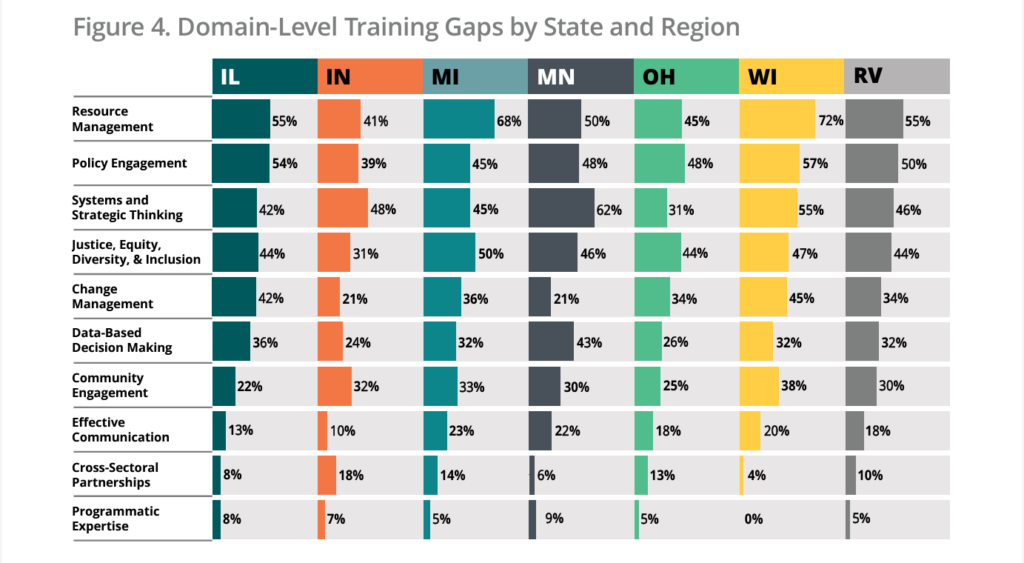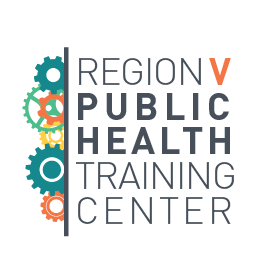By Mariana Quinn, MPH, Region V Public Health Training Center
The RVPHTC conducts a training needs assessment every few years to help identify and prioritize the current needs of the region’s Local Health Departments (LHDs). These training needs help inform the development of training resources that will best serve our users and each iteration of the training needs assessment has slight differences and helps us learn more about the LHDs that we are serving.
What is in our training needs assessment?
The training needs assessment conducted by the Region V Public Health Training Center in the fall of 2023 asked health officials whether their public health staff (defined as those who are specifically involved in delivering the 10 Essential Public Health Services) are able to apply the stated skills in their day-to-day work to sufficiently meet the agency’s needs. The survey also asked about LHD characteristics, student internship opportunities at LHDs, training networks, and injury prevention activities at their organizations. The survey was sent to all 500+ LHDs in the region and we received 234 responses.
What did we find?
When we dive into the results from this iteration of the training needs assessment, we are able to pinpoint some training gaps at the Strategic Skill domain level (nine domains identified by the de Beaumont Foundation), and also narrow down to the competency statement level. When looking at the zoomed-out domain level, the top five training gaps for the region’s LHDs are:
- Resource Management
- Policy Engagement
- Systems and Strategic Thinking
- Justice, Equity, Diversity, and Inclusion

When we zoom in and look at the competency statements across all domains that had the highest training gaps, the top five statements are:
- Implement a business plan for agency programs and services (e.g., tool for analyzing and planning for a product or service that will meet a community need, will generate revenue, and be sustainable)
- Identify and assess options for policies external to the organization that affect the health of the community (e.g., transportation routes, earned sick leave, tobacco 21, affordable housing/inclusionary zoning, complete streets, healthy food procurement)
- Examine the feasibility (e.g., fiscal, social, political, legal, geographic) of a policy and its relationship to many types of public health problems
- Use financial analysis methods in managing programs and services
- Apply quality improvement processes (e.g., Plan-Do-Check-Act, SWOT analysis, fishbone, lean, kaizen, etc.) to improve agency programs and services
Among these five statements, the domains of Resource Management, Policy Engagement, and Systems and Strategic Thinking appear more than once.
What do we do with the findings?
After completing the analysis of the survey data, we compiled a report with detailed findings that is available on the RVPHTC website. This report includes a detailed breakdown of each domain and the respective competency statements, visual representations of each state’s training networks, and recommendations that RVPHTC could potentially implement in the future.
Additionally, we collaborated with a team at the University of Minnesota to create an interactive dashboard of the data. This dashboard is publically available and anyone can go in and utilize it. The dashboard includes filters by state, staff size, population size served, and rural/urban settings. You can view the data for the Strategic Skill domains, Strategic Skill competency statements, and the Core Competencies for Public Health Professionals. Both the report and dashboard have been shared with partners and interested parties across the region, and the findings are actively used by our team to develop high-quality virtual trainings. Visit our Training Library to explore our offerings!
We encourage everyone to check out our dashboard and use the data to their advantage! Whether it’s using data as a way to provide evidence to a policy or proposal, to help fuel conversation and discussion, or just to inform yourself of what the landscape looks like, poke around and find out!
To learn more, check out this resource:
- 2023 Training Needs Assessment report and dashboard

